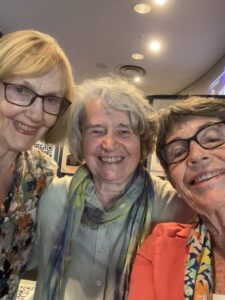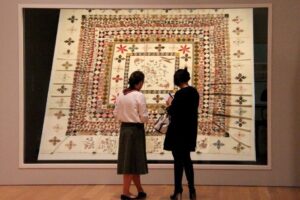

One of the joys of being part of a writing community you get to enjoy writing events more personally as you know writers. And so attending an afternoon play, written by fellow writer Cate Whittaker called Lady Franklin and the Rajah Quilt at The Riverside Theatre with my writer friend Pip Griffin was no exception.
The play titled Jane Franklin and the Rajah Quilt was based on an early AUSTRALIAN story of the convicts being shipped to Australia
THE PLAY
This moving and tragic play tells of the unjust dismissal of the highly-efficient, effective and extremely clever Governor’s wife, Jane Franklin, after working tirelessly to change Tasmania’s penal colony into a cultural centre, where girls were state educated; and convict women removed from the abuse of assignment to be taught skills.
Boarding the Rajah for home Jane faces her worst nightmare and nemesis- the reoffending convict woman, in Betsy, the Captain’s wife’s maid. The two clever women in opposite corners of life spar continually, with Jane methodically processing Betsy’s pardon, Betsy telling her, “Treat me like a person, not a problem.”
The tables are drastically turned when Jane discovers her name is notorious, being blamed for her husband’s dismissal. Unable to face life Jane is saved by Betsy, who teaches her to sew. Sitting together stitching the Rajah Quilt they share life stories, laughter, and finally their sorrows. Its Betsy’s arms Jane cries in –- a recognition of shared paths of unjust disgrace.

Cate Whittaker, the playwright and writer friend was born fifteen-kilometres from the Brontë home in Haworth and has been steeped in their legend and legacy. Cate had a successful career in Secondary Education and continue her writing in an academic field. Her MA (Thesis SYD) is in Colonial History and her research focuses on female social history.
Her play, Forgotten performed to sell-out audiences at the Parramatta Riverside Theatre in 2019, and is on the Female Convict Rebellion at the Parramatta Factory 1827. The Lost Voice of Anne Brontë, dedicated to women killed by their partners, recognises Anne’s courage in writing about the abuse of wives. Premiering last January, Sydney to encouraging reviews, “a solidly engaging play” (SMH), it will be performed in Canberra, Brisbane and Melbourne, before the UK in 2022 for Anne’s extended bicentenary.
The RAJAH QUILT

The story of the Rajah Quilt is fascinating because it is the only known surviving patchwork by women convicts, created on their voyage to Van Diemen’s Land in 1841.
The 180 women convicts were transported on board the ship Rajah from England to Van Diemen’s Land (Tasmania) While it is a compelling document of convict life, it is also an extraordinary work of art―a product of beauty from the hands of many women who, in the most abject circumstances, were able to work together to produce an object of hope.
Most of the time it lives in controlled conditions in the National Gallery of Australia textile archive. It is displayed on occasions in exhibitions commemorating the history of Australia, and the history of Quilting.
The Rajah Quilt was only possible due to the work of Elizabeth Fry and the British Ladies Society for the Reformation of Female Prisoners. Like so many other caring acts of awareness it was the Quakers who were alert to the suffering of the women and looked for practical ways to assist. Elizabeth Fry was very moved by the terrible conditions , overcrowding,and the general ‘Dickensian image of English Victorian prisons. Being aware some of the convict girls were needlework trained they sprovided bundles of sewing kits for the girls: and communal sewing supplies including tape, 10 yards of fabric, 4 balls of white cotton sewing thread, red, black,and blue thread, black wool, 24 yards of coloured patch work fabric 100 needles, thimbles, pins, scissors and 2 ponds of patchwork pieces.
On the trip with maybe the leadership of a woman Kezia Hayter, who helped run the prison and decided to come as maybe (this is questioned) she was interested in the captain of the Rajah. This was lucky for the girls. Their work turned into a quilt, embroidered and appliqued coverlet a tangible evidence of cooperative patchwork
Being at sea for 3-4 months this sewing could have had a calming effect on the group that worked together, transcended their conditions to work together in the service of art. and would be something to give them a sense of hope.
The Rajah Quilt consists of 2,815 pieces and made in the old English medallion style or framed quilt style. The English paper oieced applique called ‘Broderic perse’ a type of applique chinz



